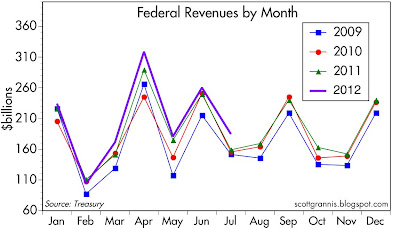Saturday, August 11, 2012
Federal budget update: modest improvement
The chart above tracks the rolling 12-month total of federal spending and revenue. From my perspective, the most notable thing to observe here is that spending has been relatively flat for the past three years. In fact, since the end of 2009, federal spending has increased by only 2%! Thanks largely to a deadlocked Congress, this "austerity" has brought spending down from a high of 25.2% of GDP in 2009 to 23.5% today. That still leaves the government commandeering a greater portion of GDP than at any time since WW II, but it is progress that cannot be denied, even by ardent conservatives. If Congress can keep this up we will eventually balance the budget without the need to raise anybody's tax rate.
The top chart also shows that federal revenues have been increasing fairly steadily since the end of 2009, and are now up by a total of over 18%! The chart above shows how monthly receipts have exceeded those of the prior year in most months this year. This is a natural part of every recovery, as incomes rise, the number of workers increases, and corporate profits rise. Revenues are still unusually weak for this stage of the business cycle, but that's mainly due to the very weak recovery and the still-large number of unemployed. The best way to boost revenues is to boost the economy.
Thanks to very slow growth in spending and the continued rise in revenues, the federal deficit has declined from a high of 10.5% of GDP in late 2009 to 8% as of last June. That's still painfully large, but it is below the 9% level that is said to be something like the point of no return—beyond which deficits can become destabilizing and the economy spirals downward.
According to my projections, by the end of this year outstanding federal debt held by the public (thus excluding debt the government owes itself, e.g., to social security) will reach approximately 75% of GDP. The chart above puts this into context, tracking the increase (red) or decrease (green) in the federal debt burden (best defined by comparing debt outstanding to GDP) by Presidential terms. Even though Obama can correctly claim to have overseen a very slow rate of growth in federal spending, he will have presided over the largest 4-year increase by far in the federal debt burden since WW II.
Subscribe to:
Post Comments (Atom)




No comments:
Post a Comment